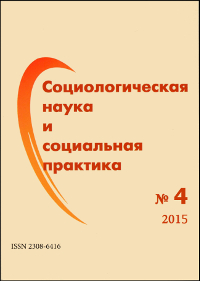Россия и БРИК: основные тренды воспроизводства человеческого капитала
Аннотация
Литература
Диденко Д. В. Трансформационные процессы и человеческое развитие // Terra Economicus. 2012. Т. 10. № 1. С. 70 – 88.
Ли Сюй. Эволюция принципа справедливости и его реализация в государственной образовательной политике Китая. Дисс. на соиск. уч. ст. канд. полит. н. М.: МГУ им. М. В. Ломоносова, 2015. – 188 с.
Осипов Г. В., Стриханов М. Н., Шереги Ф. Э. Взаимодействие науки и производства: социологический анализ. В 2 ч. Ч. 1. М.: ЦСПиМ, 2014. – 364 с.
Россия и Китай: молодёжь XXI века / отв. ред. М. К. Горшков, Ли Чунлинь, З. Т. Голенкова, П. М. Козырева. М.: Новый хронограф, 2014. – 420 с.
Россияне и китайцы в эпоху перемен. Сравнительное исследование в Санкт-Петербурге и Шанхае начала XXI века / Под общ. ред. Е. Н. Даниловой, В. А. Ядова, Пан Давэя. М.: Логос, 2012. – 452 с.
Технопарки в сфере высоких технологий [Электронный ресурс] // Официальный сайт Министерства связи и массовых коммуникаций URL: http:// www.minsvyaz.ru/ru/activity/directions/445/#section-directions (Дата обращения: 12.10.2015).
Awan A. G. Diverging trends of human capital in BRIC countries // International Journal of Asian Social Science. 2012. №2. P. 2195 – 2219.
China state of urban youth report 2014 – 2015. Equity employment and youth in china overview and summary of findings. Nairobi: United Nations Human Settlements Programme, 2014. [Электронный ресурс] // URL: http://unhabitat.org/urbaninitiatives/initiatives-programmes/urban-youth-fund/ (Дата обращения: 14.10.2015).
China Statistical Yearbook – 2011. Beijing: China Statistics Press, 2011. [Электронный ресурс] // Официальный сайт Национального бюро статистики Китая URL: http:// www.stats.gov.cn/tjsj/ndsj/2011/indexee.htm (Дата обращения: 12.10.2015).
Dewey J. Democracy and education. N. Y.: Free Press, 1966. – 418 p.
Education for all. Global monitoring report. Paris: UNESCO, 2015. – 499 p.
Global Human Capital Trends China data report. Shanghai: Deloitte China, 2015. – 150 p.
Guangzhou A. China’s Technology Parks and Regional Economic Growth // 4-th international conference on Chinese economy: The efficiency of China’s economic policy, CERDI, Universite d’ Auvergne, Clermont-Ferrand, October 23 – 24, 2003. [Электронный ресурс] // URL: http://www.sciencedirect.com/science/article/pii/ S004873330600148X (Дата обращения: 08.10.2015).
Hawksworth J. The World in 2050. How big will the major emerging market economies get and how can the OECD compete? L.: PricewaterhouseCoopers, 2006. [Электронный ресурс] // URL: http:// www.tepav.org.tr/upload/files/haber/1256628344r1748.The_World_in_2050. pdf (Дата обращения: 08.10.2015).
Hawksworth J., Chan D. The World in 2050. Will the shift in global economic power continue? L.: PricewaterhouseCoopers, 2015. [Электронный ресурс] // URL: http://www.pwc.com/vn/en/ publications/2014/world_in_2050.pdf (Дата обращения: 12.10.2015).
Hawksworth J., Cookson G. The World in 2050. Beyond the BRICs: a broader look at emerging market growth prospect. L.: PricewaterhouseCoopers, 2008. [Электронный ресурс] // URL: http:// www.pwc.com/it/it/publications/assets/docs/world-2050.pdf (Дата обращения: 12.10.2015).
Heckman J. J. China’s Human Capital Investment // China Economic Review. 2005. Vol. 16. № 1. P. 50 – 70.
Heckman J. J. The National Bureau of economic research. Working Paper. 2002.№ 9296. P. 796 – 804.
Human Capital Report 2015. Geneva: World Economic Forum, 2015. [Электронный ресурс] // URL: http://reports.weforum.org/humancapital-report-2015/ (Дата обращения: 12.10.2015).
Human Capital and Development. The Indian Experience / Siddharthan N. S., Narayanan К. (eds.). New Delhi: Springer, 2012. [Электронный ресурс] // URL: http://www.springer.com/gp/ book/9788132208563#aboutAuthors (Дата обращения: 08.10.2015).
Human Development Report 2014. Sustaining Human Progress: Reducing Vulnerabilities and Building Resilience. N.-Y.: UNDP, 2014. – 225 p.
Preachan B. K., Ojha V. P. Human Capital Formation and Economic Growth in India: A CGE Analysis // Annual Report 2009 – 10. New Delhi: National Council of Applied Economic Research, 2010. [Электронный ресурс] // URL: http://www.isid.ac.in/~planning/O%20and%20P.pdf (Дата обращения: 08.10.2015).
Summary report of the 2013 UIS innovation data collection. Montreal: UNESCO Institute for Statistic, 2015. [Электронный ресурс] // URL: http://www.uis.unesco.org/ScienceTechnology/Documents/IP24innovation-data-en.pdf (Дата обращения: 14.10.2015).
The Global Competitiveness Report 2014 – 2015. Geneva: World Economic Forum, 2014. [Электронный ресурс] // URL: http://www. weforum.org/node/145867 (Дата обращения: 14.10.2015).
The Global Innovation Index 2014: The Human Factor in Innovation. Fontainebleau, Ithaca, and Geneva: Cornell University, INSEAD, and WIPO, 2014. [Электронный ресурс] // URL: https://www.globalinnovationindex.org/userfiles/file/ reportpdf/GII-2014-v5.pdf (Дата обращения: 14.10.2015).
Xuejin Zuo. China’s Investments in Human Capital and Long-Term Development // Forum of International Development Studies. 2002. № 22. P. 57 – 72.
Ward K. The World in 2050. From the Top 30 to the Top 100. L.: HSBC Bank, 2012. – 40 p.
World Bank Knowledge Economy Index [Электронный ресурс] // URL: http:// data.worldbank.org/data-catalog/KEI (Дата обращения: 14.10.2015).








